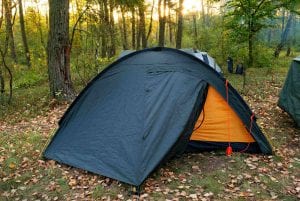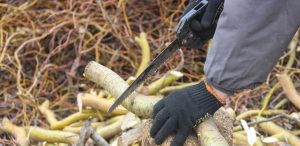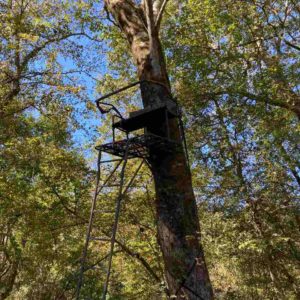Pick a sleeping bag that’s too thin in summer and you might have an uncomfortable night. No sweat (literally) — you live and learn.
But make the same mistake when the mercury drops below freezing and your problems could be a lot more serious. It’s no exaggeration to suggest that gearing up with anything less than the best 0 degree down sleeping bag would be a matter of life and death.
Less dramatically, there’s also something quite delicious about being snug as a bug in your down bag when there’s only a thin tent membrane separating you from swirling snow and biting winds.
The trouble is, sleeping bag jargon can be quite confusing, and gear manufacturers have a tendency to over-sell their products.
Terms like “warm” or “lightweight” get bandied about without much context, and you can feel well and truly lost before you’ve even set foot in the mountains.
To help you out, we’ve picked six of the best 0 degree bags for winter camping, from high-end backpacking models to value picks including:
- Sierra Designs Nitro 0 – arguably the best because of the awesome weight to price to warmth ratio
- Mountain Hardware Phantom 0 – seriously lightweight for a 0 degree down bag
- Kelty Cosmic 0 – super warm and insanely cheap for a down winter bag, but heavy and bulky
Sierra Designs Nitro 0 – Best 0 Degree Down Sleeping Bag
Specs
The Nitro 0 from Sierra Designs features 800 fill-power down, with a comfort rating of 15°F and a lower limit of 2°F. It weighs in at 2lb 8oz and packs down to 16″ x 9″.
It’s got draft tubes along the zip and neck, with an unusual self-sealing foot vent that you can use to cool off if you need to.
The down fill is treated with special “Dridown” polymer, which gives the individual filaments a degree of water-repellency. The manufacturer says that “Dridown” stays dry ten times longer and dries 33% faster than its untreated equivalent.
The Verdict
It might not be the cheapest one on this list, but we’re seriously impressed with what your money gets you here.
Priced at the lower end of mid-range, the Nitro 0 offers top-quality 800-fill down that will keep even cold sleepers toasty down to 15 degrees. It’s very lightweight for a four-season bag, and the hydrophobic treatment on the down is an unexpected and welcome bonus.
Surprisingly, the Nitro boasts a relatively roomy fit for its type, and reviewers have struggled to find any criticisms apart from minor niggles over the three-quarter-length zip.
The only thing worth noting is that it’s not that warm in the overall scheme of winter sleeping bags, so it’s worth just checking it against your anticipated camping temperatures before you pull the trigger.
Summary
Lightweight, warm, and water-resistant, the Nitro offers high-end quality with a mid-range price tag. Perfect for backpacking, ski-touring, and general four-season use — so long as the temperature ranges fit.
Mountain Hardwear Phantom 0 – Lightest 0 Degree Down Bag
Specs
Substantially more expensive than the other sleeping bags on this list, the cost is reflected in the top-dollar materials. The Phantom 0 features 850 fill-power goose down with a recommended temperature range of 0–15°F, yet it only weighs 2lb 7oz.
And, while the down itself isn’t treated for waterproofing, the recycled nylon taffeta shell features a durable water-repellent (DWR) coating.
Available in three lengths, everything about the bag is optimized for warmth retention — from the draft collar and down-filled face gasket, to the contoured mummy fit and efficient four-chamber hood design.
The Verdict
The Mountain Hardwear Phantom 0 is a premium product with a premium price tag. That’s partly due to the Mountain Hardwear brand name and reputation, but mostly it’s the 850 fill-power goose down that drives the cost up.
What that gets you, of course, is unrivaled warmth for weight. This version of the Phantom is as light as your average three-season bag, but a warm sleeper could take it down to the kinds of temperatures where your eyes freeze shut if you blink too long.
Smaller campers (including many women) will also appreciate the availability of a “short” length for people under 5’7″. Compared to the regular size, this will take less body heat to warm up, and shaves off 2oz in weight.
Apart from cost, the main downside is the fit. The narrow “contoured mummy” shape is lightweight and warm, but it can feel quite restrictive — and several reviewers have flagged this.
Summary
Expensive and slim-fitting, but you’re unlikely to find better warmth for weight. One for serious back-country backpackers embarking on challenging winter adventures.
Kelty Cosmic Down 0 – Best Budget 0 Degree Down Bag
Specs
A generous stuffing of budget-friendly 550 fill-power duck down gives this bag a comfort rating of 17°F — with a lower limit of 4°F for the warmest sleepers.
The sturdy nylon outer has an eco-friendly water-repellent coating, and there are draft tubes at the neck and zipper to keep the heat in. A handy inside pocket will also hold your flashlight or cell phone.
The Cosmic Down 0 weighs in at 4lb 9oz, and packs down to 10″ x 19″. The regular size will fit campers up to 6′ tall (a long version is also available), and the foot box is cut roomier than most.
The Verdict
Talk about bang for buck!
The Cosmic Down 0 from Kelty offers cold-weather performance at a seriously appealing price. Whether you class it as a three- or four-season bag will depend on where you live, but a comfort rating of 17°F is plenty warm enough for winter camping in many places.
The kicker is the weight. The Kelty is by far the heaviest and bulkiest bag on this list, and it’ll be too chunky for most backpackers.
Availability
You should be able to pick up one of these at the following stores:
- Check out prices on Amazon >>
- Check out prices at the Kelty web shop >>
Summary
Fantastic value, but what you save in greenbacks you pay for in weight. Probably too heavy for hiking, but great for the truck-bed, basecamp, or canoe.
Mountain Hardwear Bishop Pass 0 – Best Base Camping 0 Degree Down Bag
Specs
Utilizing 650-fill down, the Bishop Pass 0 weighs approximately 3lb 5oz and packs down to 9″ x 17″. It’s got a comfort rating of 15°F, with a lower limit for warm sleepers of 0°F.
A down-filled face gasket locks warm air in, while draft tubes round the shoulders and along the zipper keep the cold out.
The tailored mummy cut offers good warmth for weight, and the nylon shell has a durable water-repellent (DWR) treatment to protect the down fill from moisture.
The Verdict
If you want to understand how the quality of down affects the price and performance of a sleeping bag, consider how similar the Bishop Pass and the Phantom (above) are.
Same brand, same temperature range, broadly similar design — but the Bishop Pass is nearly a pound heavier and less than half the price of the Phantom.
The big difference? It uses 650 fill-power down instead of 850.
Alright, so the Bishop Pass is quite bulky for a backpacking bag, but that’s because it’s built for really cold weather. Remember that a heavier load is often unavoidable in winter — and extra weight isn’t so much of an issue if you’re using a sled or snowmobile.
Of course, it’s also great for cabins and car camping.
Compared to the Phantom, the Bishop Pass is also a little roomier inside — with an extra four inches on the shoulders — so it could be a good choice if those super-slim “contoured mummy” bags are just a bit too tight for you.
Summary
Size and weight make this bag better suited to basecamp than backpacking, but it offers the cold-weather performance of Mountain Hardwear’s high-end models at a more appealing price point.
It’s a versatile jack-of-all-trades, and a great entry-level option if you’re looking to dip a toe into the icy waters of winter camping.
Sea to Summit Ascent 0 – Most Versatile 0 Degree Down Bag
Specs
The Sea to Summit Ascent 0 has a comfort limit of 15°F and a lower limit of 0°F. Filled with high-grade 750 fill-power down, it weighs in at a comparatively lightweight 2lb 15oz, and compresses down to a volume of 8.2L.
The down has been treated for water-resistance with Sea to Summit’s “ULTRA-DRY” polymer coating. They claim it will absorb 30% less moisture than untreated down and retain 60% more loft when wet — as well as drying out 60% faster.
Unusually, this model features three zips, allowing you to open it right out into a comforter if needs be. Other features include a draft collar and zip tube, plus a handy zippered stash pocket.
The Verdict
With decent warmth-to-weight and an upper mid-range price tag, the Ascent is a decent all-rounder with a couple of stand-out features.
The first of these is Sea to Summit’s “ULTRA-DRY” down. If they’re to be believed, this offers some of the best water-resistance on the market, effectively canceling out the biggest Achilles heel of down bags.
Then there’s the zipper system, which has had great feedback from users in the field. You’ve got a full-length zipper down one side, a half-length one down the other, and a foot box zipper at the bottom.
This lets you fine-tune your ventilation and perhaps use the Ascent in slightly warmer conditions than it was designed for. You can also open it out into a comforter or zip it together with another Sea to Summit bag to make a double.
Summary
A versatile, feature-filled bag that’s light enough for backpacking and offers fantastic water-resistance. The adaptable zipper system means you can use it in the warmer seasons too, though the price point is a little on the high side.
Therm-a-Rest Questar 0
Specs
The recommended temperature range of the Therm-a-Rest Questar 0 goes from a comfort rating of 14°F down to a lower limit of 0°F. Draft tubes round the collar and along the zipper keep the heat locked in, and there’s a cinch cord on the hood.
The filling is 650 fill-power Nikwax Hydrophobic Down, which absorbs 90% less water than untreated down and dries three times faster. Other features include connecting loops for pads, quilts and blankets, plus a unique foot-warmer pocket.
The Questar weighs in at a relatively lightweight 2lb 11oz, with a fairly middle-of-the-road price tag for a winter bag. As well as the usual regular and tall options, Therm-a-Rest also offers a short-length Questar for campers under 5’5″.
The Verdict
The real big hitter here is the Nikwax Hydrophobic Down, which is the market-leader in water-resistance. Compare it to any of the other down treatments on this list, and you’ll see that the water-repellency and drying times are on a whole other level. So you’re kind of getting a bag that combines the best features of both down and synthetic fills.
And the Questar is no slouch in other respects either.
Warmth and weight are both decent for the price, and reviewers have been impressed by how small it packs down. We’re particularly taken with the beefed-up foot-box that guards against icicle toes — the scourge of many a winter camp-out.
Summary
Warm, lightweight, and compact enough for winter backpacking — the Thermarest Questar 0 is reasonably priced and features some of the best waterproofing technology out there.
How to Choose the Best 0 Degree Down Sleeping Bag
Temperature ranges
When you’re buying a winter sleeping bag, you’ll want to compare the bag’s estimated warmth against the temperatures you’re likely to encounter in the great white yonder.
Unfortunately, this is sometimes easier said than done.
The best way to judge the warmth of a sleeping bag before you buy it is to look at its ISO temperature ratings. These ratings are obtained through a standardized testing process that lets you compare sleeping bags from different brands.
The first figure you need to know is the comfort rating. This is the lowest temperature at which a cold sleeper would feel comfortable.
Then you have the limit, which is the lowest temperature at which a warm sleeper would be comfy.
The area between these two figures is often called the transition range. Somewhere along this temperature scale, you will start to feel cold, and the point at which you do will depend on whether you’re a warm or cold sleeper.
If you don’t know which you are, it’s safer to work off the comfort rating. Remember it’s easier to vent a bit of heat than it is to stay warm in a bag that’s too thin.
The problem is that manufacturers aren’t consistent in the way they use ISO ratings, and so they can sometimes be misleading. For example, in the case of unisex or men’s sleeping bags, brands will usually market them (and often even name them) based on the lower limit — despite the fact that only the warmest sleepers will feel comfortable at those temperatures.
In the case of unisex bags, you may also see references to a “women’s limit” (the comfort rating) and a “men’s limit” (the lower limit). While it’s true that women do tend to sleep colder than men, this is clearly a massive generalization, so it’s more important to know where on the spectrum of hot and cold sleepers you fit.
Weight
Obviously, weight isn’t an issue if you’re using motorized transport or operating out of a basecamp, but backpackers will be hoping to snag a four-season sleeping bag that’s both warm and relatively lightweight.
We’ve yet to encounter a winter sleeping bag that’s genuinely “ultralight” — whatever the product descriptions would have you believe.
The fact is, you do have to carry more weight to enjoy the outdoors safely in winter, and those 12oz summer bags just aren’t going to cut it when temperatures drop below freezing.
However, you’ll see that there are several sleeping bags on this list in the sub-3lb category, and most of them achieve this by using high fill-power down.
Fill Power
Fill power measures the warmth-to-weight ratio of the down filling.
The miracle quality of down is its ability to puff up (or “loft”) when you take the sleeping bag out of its stuff sack. Higher-grade down has better lofting performance, and will fill a larger space — providing the same amount of insulation for a smaller weight of down.
With this in mind, fill power tells you how many cubic inches a single ounce of down will expand to fill. For example, one ounce of 700 fill-power down will take up 700 cubic inches of space.
The warmth of the bag still depends on how much insulation you use, but using higher fill-power down will give you the same amount of warmth for less weight. It will also ratchet up the cost of the bag significantly.
Water-resistance
As you’ll know if you’ve read our guide to down vs synthetic sleeping bags, the big drawback of down bags is that they don’t mix well with moisture.
Get them wet and their insulating properties are massively compromised.
These problems can be more acute in winter. You may end up getting quite wet if you’re doing strenuous exercise in snowy conditions, plus tent condensation can be more of an issue.
Not only that, but getting a down sleeping bag dried out is hard enough in summer, let alone in winter.
Depending on what winter adventures you’ve got in store, it’s really worth considering a sleeping bag with some degree of water-resistance.
In some cases, this might be a durable water-repellent (DWR) coating on the shell fabric, but a number of ingenious manufacturers have also devised innovative polymer treatments for the down itself.
These can be so effective that down bags perform as effectively in damp conditions as their synthetic counterparts.
FAQs
Will a 0 degree sleeping bag keep me warm?
Not always. In some places, winter temperatures can drop well below 0 degrees, so you’ll need to check your gear against real-world weather data before you set out.
How good is a 0 degree sleeping bag?
It’s important to look at the tech specs to discover whether 0 degrees is the “comfort rating” of the sleeping bag or the “lower limit.” If it’s the latter, you may still feel cold at those temperatures.
What type of sleeping bag is best for cold weather?
Most cold-weather sleeping bags are filled with down, and the best ones will feature water-repellent treatments.
What is the best budget winter sleeping bag?
The best budget winter sleeping bag on this list is the Kelty Cosmic Down 0 — which is ideal for car camping, cabin, and basecamp use.






